
Reviews
A deeply illuminating work on aspects of material culture... which shaped following ages.
Phillippy strikes a delicate interpretive balance between contemporary criticism and specific historical periods, cultures, and genres that will undoubtedly guide future research.
One will undoubtedly be enriched by many of the previously obscured glimpses that she has succeeded in unveiling.
Painting Women: Cosmetics, Canvases, and Early Modern Culture not only offers an enlightening argument, but also a productive direction and excellent model for feminist scholarship.
This complicated subject leads to a study of early modern culture in England, France and Italy that is revealing.
Painting Women makes a worthwhile contribution to the study of women and gender identity in early modern art and literature, and is likely to be of interest to scholars of early modern art, literature, and history.
This ambitious project involves imaginative, if not acrobatic, yokings of the verbal and visual arts.
Painting Women makes an important contribution to the study of representation in early modern Europe.
Phillippy's focus on the semantic slippage of 'painting' as verb, adjective, and noun yields a brilliantly substantive way of thinking about the individual discourses of painting, cosmetics, and poetry as they arise from a common historical background. Thoughtful, polished, and, best of all, intellectually engaging.
Book Details
List of Illustrations
Acknowledgements
Introduction
Chapter 1. Painting Women: Spectacle and Subjectivity
Chapter 2. Public Women: Female Friendship on Trial
Chapter 3. The Mirror of Socrates
Chapter 4
List of Illustrations
Acknowledgements
Introduction
Chapter 1. Painting Women: Spectacle and Subjectivity
Chapter 2. Public Women: Female Friendship on Trial
Chapter 3. The Mirror of Socrates
Chapter 4. Colors and Essence
Chapter 5. Custom, Conscience, and the Reformation of Painting
Conclusion
Notes
Bibliography
Index





